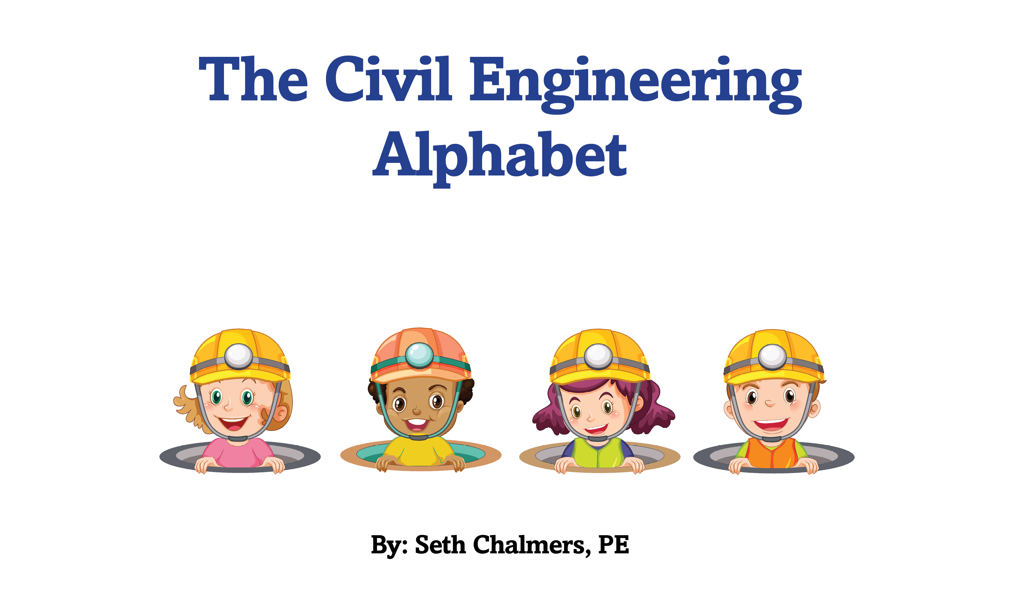The Civil Engineering Alphabet
Thank you for visiting the companion webpage for The Civil Engineering Alphabet by Seth Chalmers, PE, Director of Traffic Engineering at Dibble. Below you will find information on civil engineering college programs, professional organizations, and STEM resources for students.
Civil Engineering Education
Civil engineering is a broad and diverse branch of engineering that focuses on the built environment and what is needed to create and sustain it. The goal is to improve communities and enhance lives. Civil engineers use applied sciences such as math, chemistry, and physics to define and solve problems using effective, efficient, and safe techniques and approaches. The practice of civil engineering encompasses many of the disciplines areas known as STEM (science, technology, engineering, and mathematics).
It is important to note that civil engineers are not scientists or mathematicians. While some civil engineers may focus more on science or mathematics in research or academic settings, most civil engineers use STEM principles for planning, design, and construction. You do not necessarily have to excel at math or science to study civil engineering (or engineering in general). What matters most is a deep curiosity to know how things work, to design and build things using STEM, and to define and solve problems with motivation and passion.
Civil engineering as a profession dates back to the late 1700s, when the term “civil” was used to distinguish it from “military” engineering. Originally, civil engineering was a learned profession – engineers learned while working as a surveyor on projects such as roads and canals. In 1802, civil engineering education became formalized when the United States Military Academy at West Point was formed. The first non-military civil engineering degree was conferred by Rensselaer Polytechnic Institute in 1835. To become a civil engineer, the first step is to earn a Bachelor of Science in civil engineering degree.
Universities with Civil Engineering Programs
In the United States, over 200 universities and colleges offer programs in civil engineering. The mission of these civil engineering education programs is to prepare students to be proficient in civil engineering and related fields and get them ready to help improve, operate, and maintain infrastructure for the public good. This includes fostering the ability to think creatively and critically to define and solve problems in a manner that is economically sound and fair to all people.
Universities in the Southwest with civil engineering programs are listed below by state. A listing of universities across the United States with civil engineering programs can be found here.
Arizona
- Arizona State University (ASU) – Ira A. Fulton Schools of Engineering
- Northern Arizona University (NAU) – Civil and Environmental Engineering
- University of Arizona (UArizona or U of A) – Civil and Architectural Engineering and Mechanics (CAEM)
Colorado
- Colorado School of Mines – Civil and Environmental Engineering Department
- Colorado State University Fort Collins – Walter Scott, Jr. College of Engineering
- Colorado State University Pueblo – School of Engineering
- Metropolitan State University of Denver – Department of Engineering and Engineering Technology
- United States Air Force Academy – Department of Civil and Environmental Engineering
- University of Colorado Boulder – Civil, Environmental and Architectural Engineering
- University of Colorado Denver – College of Engineering, Design and Computing
Nevada
- University of Nevada, Las Vegas – Howard R. Hughes College of Engineering
- University of Nevada, Reno – College of Engineering
New Mexico
- University of New Mexico – School of Engineering
- New Mexico Institute of Mining and Technology
- New Mexico State University – College of Engineering
Utah
- University of Utah – John and Marcia Price College of Engineering
- Utah State University – College of Engineering
- Utah Valley University – Smith College of Engineering and Technology
- Brigham Young University – Ira A. Fulton College of Engineering
Community College to University Pathway
Some college students choose to begin their college studies at a community college or smaller university without a civil engineering department, then transfer to a four-year university to complete their civil engineering degree. This pathway often takes extra time but can be a more economical way to achieve an engineering degree.
Engineering Professional Organizations
The oldest engineering professional organization is the American Society of Civil Engineers (ASCE), which was formed in 1852. Below are some links to specific programs ASCE has regarding engineering education and civil engineering as a profession.
- ASCE Civil Engineering Student Resources
- ASCE Pre-College Outreach
- ASCE Career Connections
- ASCE Historic Landmarks
Additional engineering professional organizations fall under various civil engineering disciplines.
General Engineering
- American Council of Engineering Companies (ACEC)
- American Public Works Association (APWA)
- National Academy of Engineering (NAE)
- National Society of Professional Engineers (NSPE)
Transportation/Traffic Engineering/Traffic Safety
- American Association of State Highway and Transportation Officials (AASHTO)
- American Public Transportation Association (APTA)
- American Society of Highway Engineers (ASHE)
- American Traffic Safety Services Association (ATSSA)
- Institute of Transportation Engineers (ITE)
- Intelligent Transportation Society of America (ITS America)
- Society of Automotive Engineers (SAE)
- WTS International
- Young Professionals in Transportation
Water Resources Engineering
- American Water Resources Association (AWRA)
- American Water Works Association (AWWA)
- International Water Resources Association (IWRA)
- Water Environment Federation (WEF)
- Water Professionals International (WPI)
Structural Engineering
Electrical Engineering
Construction Engineering
- American Concrete Institute (ACI)
- American Institute of Constructors (AIC)
- American Institute of Steel Construction (AISC)
- Associated Builders and Contractors (ABC)
- Associated General Contractors of America (AGC)
- ASTM International
- International Code Council (ICC)
Environmental Engineering
- Association of Environmental Engineering and Science Professors (AEESP)
- National Association of Environmental Professionals (NAEP)
Survey
Urban Planning/Land Development
- American Planning Association (APA)
- Commercial Real Estate Development Association (NAIOP)
- Urban Land Institute (ULI)
- U.S. Green Building Council (USGBC)
Aviation Engineering
Energy/Power Engineering
- Association of Energy Engineers (AEE)
- Association of Energy Services Professionals (AESP)
- IEEE Power and Energy Society (IEEE PES)
STEM Resources for Elementary, Middle, and High Schoolers
- ASCE Kids and Teens
- Discover Engineering
- Engineer Girl
- Engineering for Kids Program
- Engineering, Go For It! (eGFI)
- Environmental Protection Agency (EPA) Students
- How Stuff Works
- Kids Ahead
- NASA Space Place
- PBS Kids – Design Squad Global
- Reading Rockets
- Science Buddies
- Science Kids
- Science Notes
- Scratch
- STEAM Powered Family
- STEM Career
- STEM Works
- Teach Engineering
- Try Engineering
- Additional STEM Resources for Middle School
- Additional STEM Resources for K-12


